Early in the morning of what became a steamy midsummer day, Bendu Kollie watered a set of oak seedlings growing in a field on West Broadway. A tornado that churned through north Minneapolis a decade ago left this and other parts of the neighborhood vacant and exposed to the sun.
"You see concrete everywhere," said Kollie. "It emanates more heat even when it's cool. When it rains, the heat comes out as vapor."
Lower-income neighborhoods in Minneapolis are hotter than ever after the 2011 storm — bookended by a recession and the arrival of emerald ash borer — wiped out much of the tree cover. These so-called heat islands are becoming more pronounced across the country, and the people who live and work in these communities are experiencing more heat-related illnesses, higher utility costs and elevated pollution that worsens ailments like asthma and heart disease.
The north Minneapolis tornado cut a 3.5 mile swath up to half a mile wide across the neighborhoods of Folwell, Jordan, Willard-Hay and Webber-Camden, destroying 150 acres of trees.
That single storm accounted for most of Minneapolis' tree canopy decline between 2009 and 2015. In comparison, St. Paul's canopy grew, according to a University of Minnesota study.
A giant scar stretching across north Minneapolis is still evident in satellite imagery.
Yet despite donations and volunteers to replace the city's trees, replenishing the canopy over the past decade has been a struggle.
National groups lavished praise on the Minneapolis Park Board for swiftly replanting the 2,600 trees blown down in parks and boulevards.
But the bigger and more vexing problem was massive tree loss on private property — estimated to be two to three times greater. The tornado hit around the same time as a deepening foreclosure crisis allowed investment rental companies to buy up north Minneapolis homes by the hundreds. The new landlords showed little interest in planting trees, and many remaining homeowners lacked the money to do so. To this day, an untold number of trees have never been replaced.
Add to that the ravages of the emerald ash borer — the voracious bug attacking the species that arborists planted en masse 40 years ago thinking it would be a good substitute for ailing Dutch elm.
There is no doubt that Minneapolis has been losing tree canopy over the past decade, said Karen Zumach, director of community forestry at Tree Trust, the organization partnering with the city to plant trees on private property.
It's going to take a long time, Zumach said, to simply finish replacing the lost trees, let alone expand the canopy.
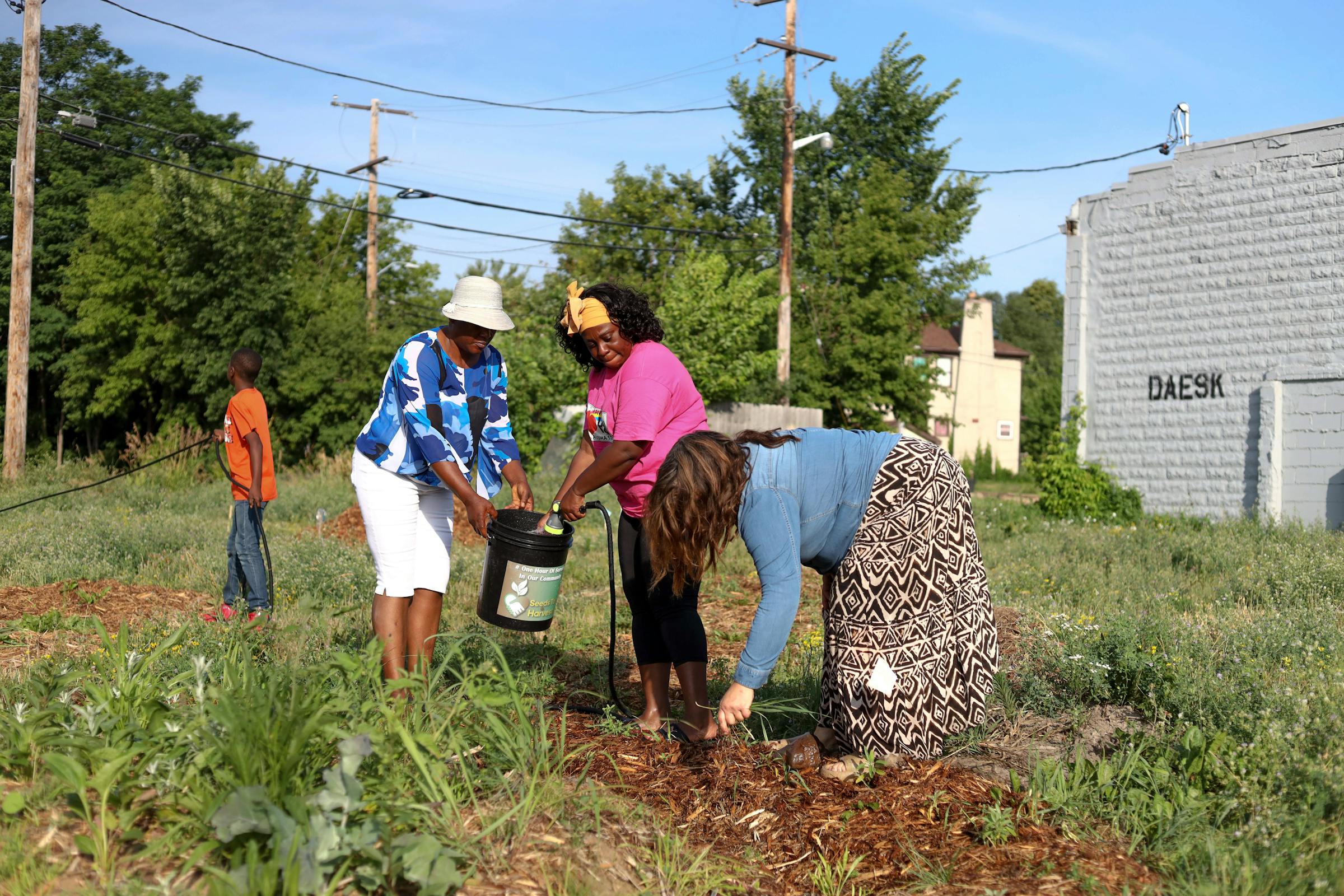
Under a blazing July sun, members of the Sunnyside Peace and Prayer Project watered plants and young trees growing in a vacant lot of West Broadway.
Public commitment, private hesitation
As part of his maintenance rounds one summer day, park worker Bruce Enstad parked his watering truck in the 3200 block of N. Knox Avenue, unspooled its hose and filled a 20-gallon water bag swaddling a boulevard sapling. It's one of dozens he got to that morning to help ensure that new trees survive.
This pocket of heat in north Minneapolis is a living diorama of the high-pressure life cycle of urban trees.
Some saplings were recently mowed over by errant drivers. Across the street, lanky adolescent trees planted after the 2011 tornado have reached 10 inches in girth, close to filling the canopy but not quite there.
On the next block, trees narrowly missed by that storm loom dark and 60 feet tall.
City and Park Board teams worked overtime for a month after the tornado to clear the streets. Lions Club members and companies donated money and labor through the Northside Treecovery campaign. By the fall of 2012, the Park Board had planted 3,200 saplings, primarily bareroot trees of at least an inch in diameter, in stricken neighborhoods.
"Many communities have disparities, where that tree canopy hadn't been planted in the past based upon whether they're poor communities, non-white communities, and those are decisions of neglect made 50 years ago," said Kevin Roth of the National Recreation and Park Association. "To see Minneapolis — when that event occurred a decade ago — commit to get that canopy in place is extraordinary."
The Minneapolis Park Board's Forestry Department sits plush among that of other American cities, with a budget of $10 million a year and taxpayers willing to shoulder an extra levy from 2014-2021 just to plant trees on public land.
The bigger challenge remains reforesting private property.
In the weeks after the tornado, then-mayor R.T. Rybak wanted to drive around with a flatbed of trees and hand them out, recalled Zumach of Tree Trust. They opted against it because so much of north Minneapolis was rental property and certain landlords were not interested.
Residents were inundated with expenses. Houses had blue tarps on their roofs. Cars had been crushed. The power was out and people were grilling the contents of their refrigerators.
"It's also important to recognize that a lot of the damage caused in north Minneapolis was caused by trees, so there was a really big mental shift that needed to happen to help people understand the benefits of trees," Zumach said. "When somebody has to deal with insurance companies and roofers and all these things, and then you're trying to convince them that they also need to get a new tree, it's just a real hard sell."
Over a decade of trying to persuade private property owners to take trees, she has heard all the reasons someone might refuse: the raking and the squirrels, gardening and blocking solar panels.
Saturday mornings at North Commons Park, there are activities that aim to bring young people closer to the environment.
Coach Mike Tate leads a group of volunteers on an hourlong hike through the neighborhood, scooping litter out of storm drains. They learn about polluted runoff and the stormwater-catching power of trees, which reduce flooding. At the end, the group breaks into a relay race to water a stand of saplings they planted that Arbor Day.
"When we're watering them, we want to give them love and energy," said Erika Schlaeger dos Santos of Sunnyside Peace and Prayer Project, who distributes seedlings throughout north Minneapolis to anyone who will take them.
One sapling is dedicated to Deshaun Hill, the North High quarterback slain in February.
"Look at that field over there with no trees," environmentalist Kristel Porter told the group afterward, gesturing at the pale yellow lawn of the school across the street. "I bet you could put your bare foot on it and it would hurt your foot because it's so crunchy. Now look here." She pointed down at the cool turf of North Commons.
Porter challenged the water racers to push for trees on their school and church grounds — anywhere with space — and to imagine forests in place of manicured lawns.
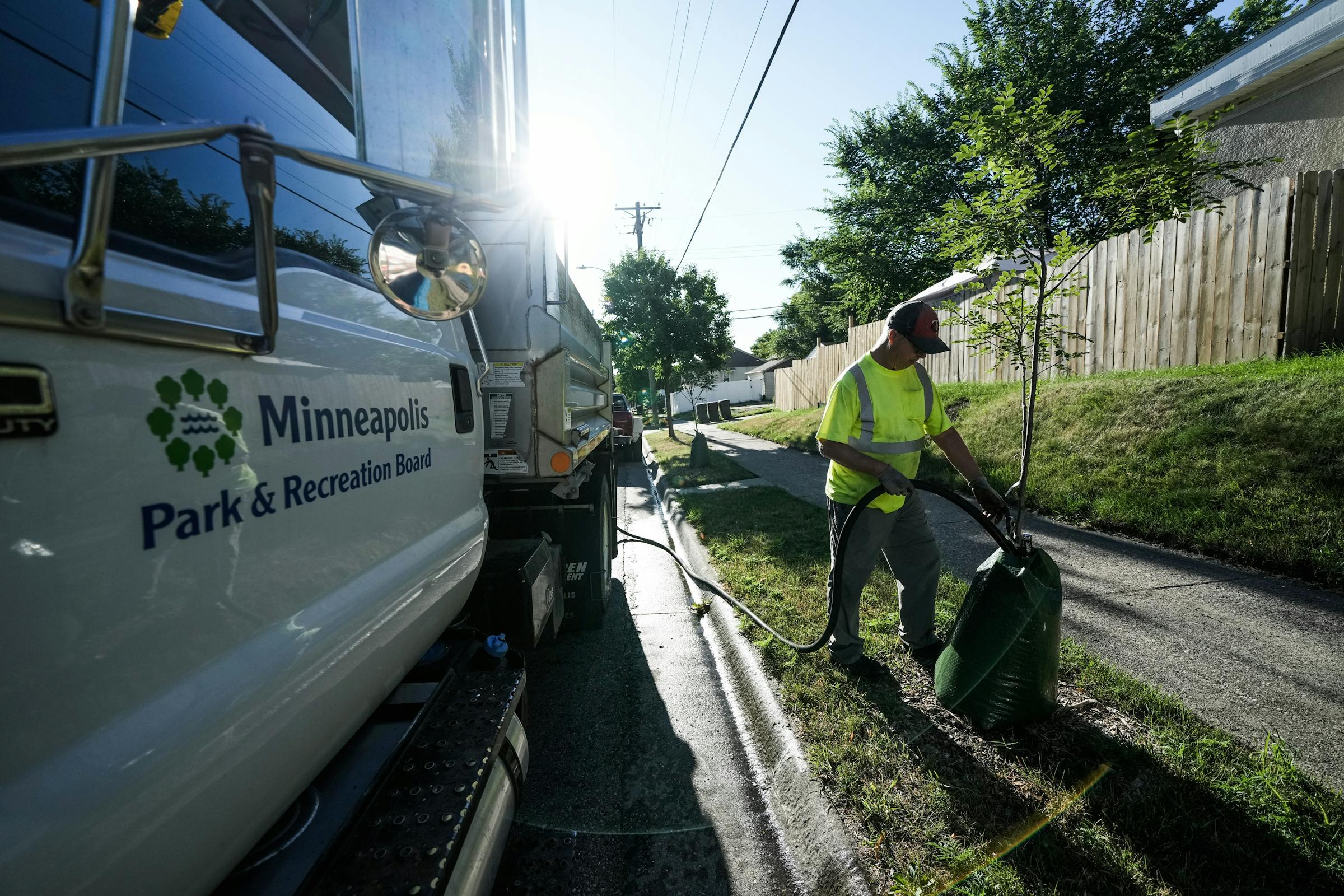
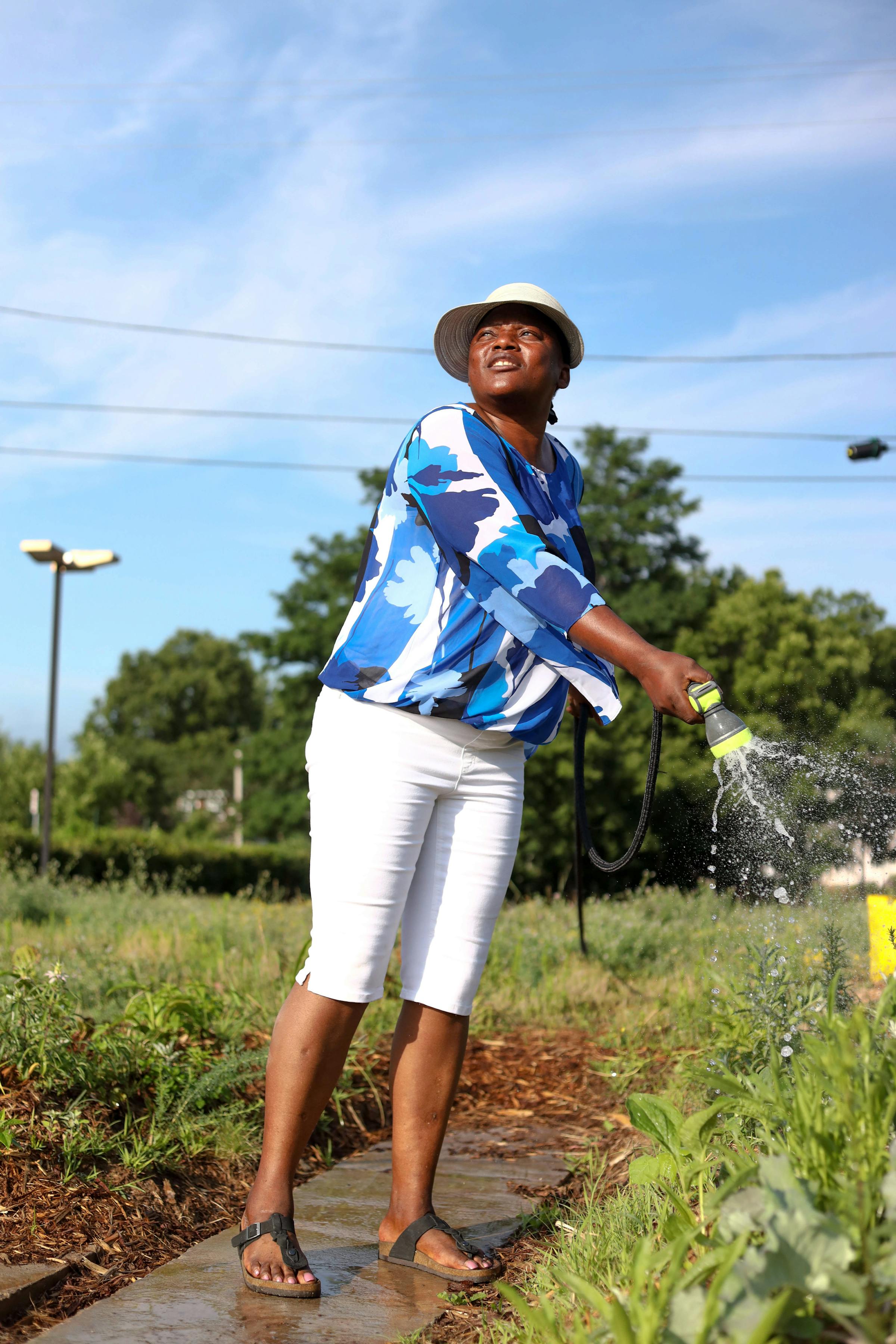
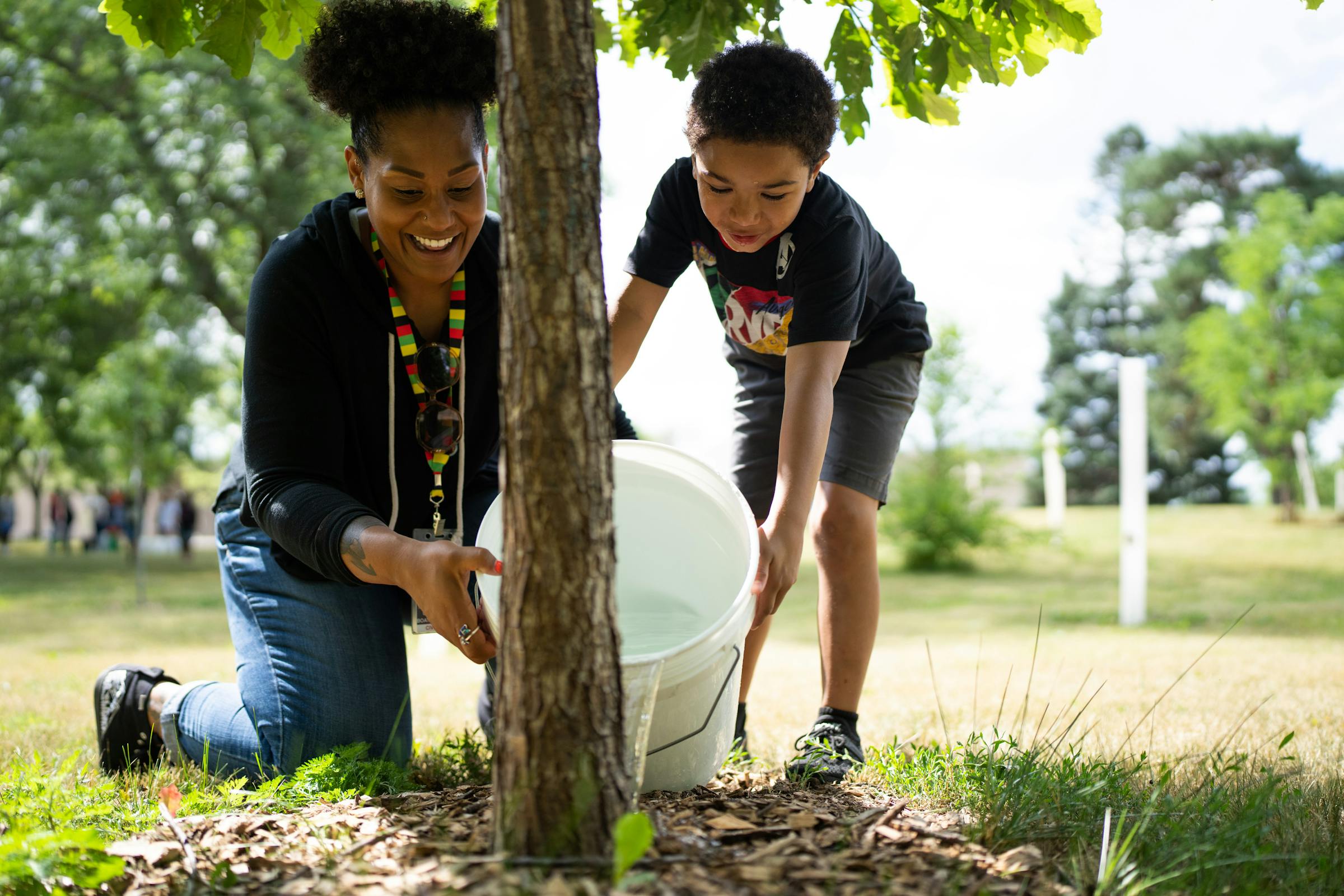
City and private nonprofits are both working to fill out Minneapolis' canopy. At top, Minneapolis Park and Recreation Board worker Bruce Enstad filled 20-gallon water bags attached to saplings in north Minneapolis, and Lenda George of the Sunnyside Peace and Prayer Project watered seedlings in a vacant lot on West Broadway. Above, Chaunte Ford, juvenile outreach coordinator with Metro Transit, helped 7-year-old Micheal Johnson-Solix water saplings at North Commons Park in July.
Competing land uses
Money and reluctant landowners are not the only factors impeding tree canopy recovery in north Minneapolis. There are competing dreams for limited space, in addition to the continuing loss of trees to emerald ash borer.
Since the 2011 tornado, a string of urban gardens popped up in its path. Some are now five to 10 years old and serve as outdoor classrooms where Project Sweetie Pie founder Michael Chaney teaches North Side students agriculture and business sense.
Growing food in the wake of catastrophe is what he calls "making lemonade out of lemons."
Minneapolis Public Schools, one of the largest property owners in the city, is losing half its 600 trees across 76 sites to emerald ash borer. The removals will leave ash-heavy schools like Lucy Laney and Olson starkly changed, said Curt Hartog, district facilities director.
The school district has more surplus land and underutilized sites in north Minneapolis than anywhere else — such as Cooper and Victory Memorial Ice Arena, both used for storage. But the idea of filling their fields with trees is touchy because those spaces still get rented out for sports, he said.
"There has to be a lot of input from the community before we try to convert something like that," Hartog said.
The tension between growing the urban forest and reserving spaces for social activity is also playing out at the Upper Harbor Terminal, a redevelopment of 48 acres of industrial riverfront. More than 19 acres will become a new park guided by the community's needs as it reconnects to the river for the first time since Interstate 94 severed that relationship.
Feedback gathered over more than 100 meetings expressed stronger support for open picnicking lawns. Some would rather that the park offer job training over leisure. Planners ultimately settled on a first design principle: that the park be "just green enough" to counter green gentrification — the idea of improved environment begetting higher property values and displacement.
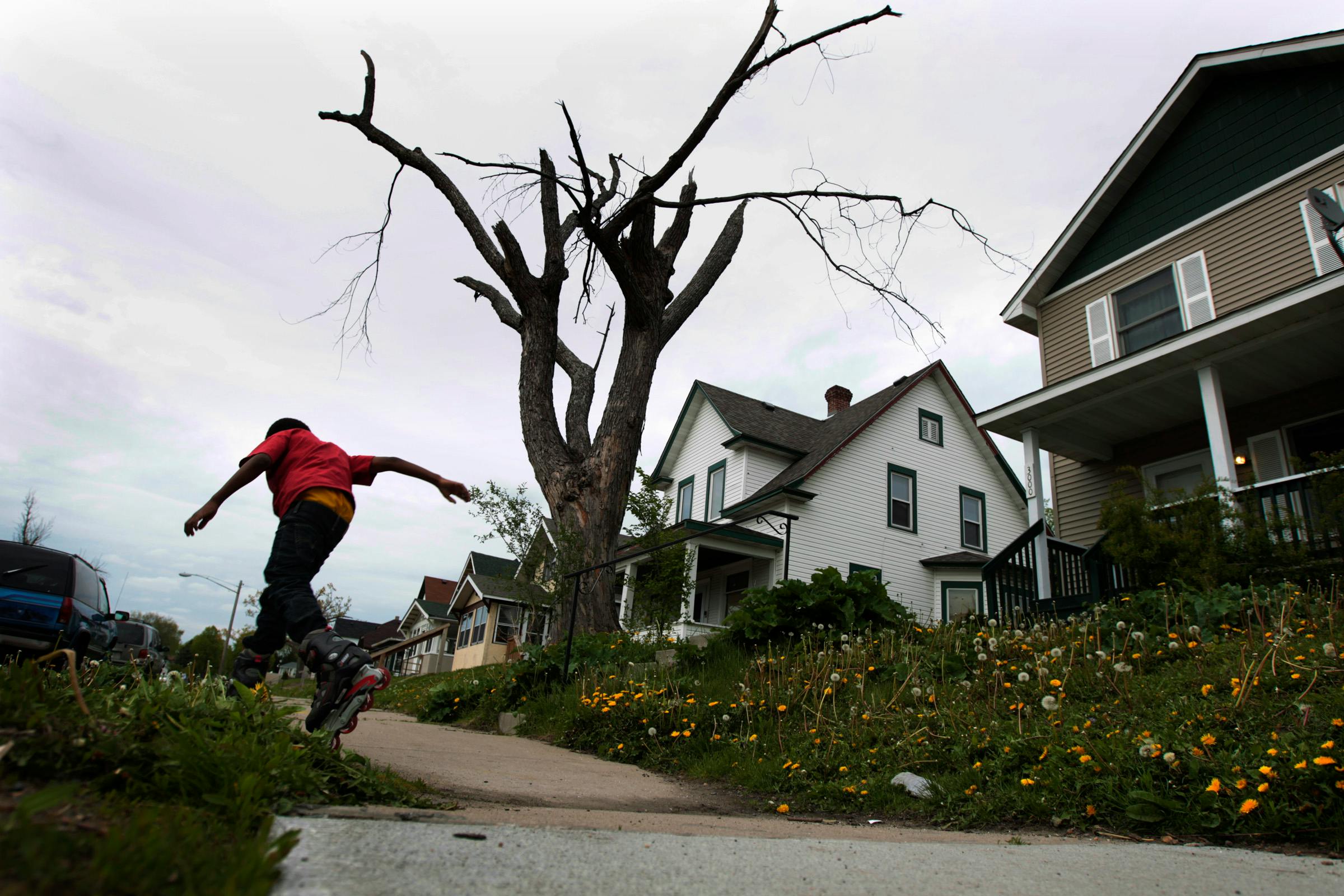
A year after the 2011 tornado, a damaged tree still stood on Logan Avenue N. in north Minneapolis. A decade later, the damage to the urban forest remains visible.
The last time it happened
Southwest Minneapolis is an example of what a tornado-ravaged community could look like in 40 years.
A tornado formed around 50th and France in the summer of 1981. It bowled over neighborhoods from Lake Harriet to Roseville, killing 3,500 trees on public property, including the Lyndale Park Rose Garden and Roberts Bird Sanctuary. Then as in 2011, tree loss on private property was not inventoried but estimated to be far greater.
Today the Southwest community is more lush and leafy, with an average tree canopy coverage of 38%. In comparison, canopy coverage in Camden and Near North is 28% and 26%, respectively. The Metropolitan Council considers 45% to be ideal.
Randy Windsperger was a 26-year-old private contractor for the Park Board in 1981 and recalls the devastation of the Lake Harriet neighborhood. Even then it was an affluent part of town, with families who held onto the same houses for generations, taking pride in their trees because of what they brought in curb appeal, he said.
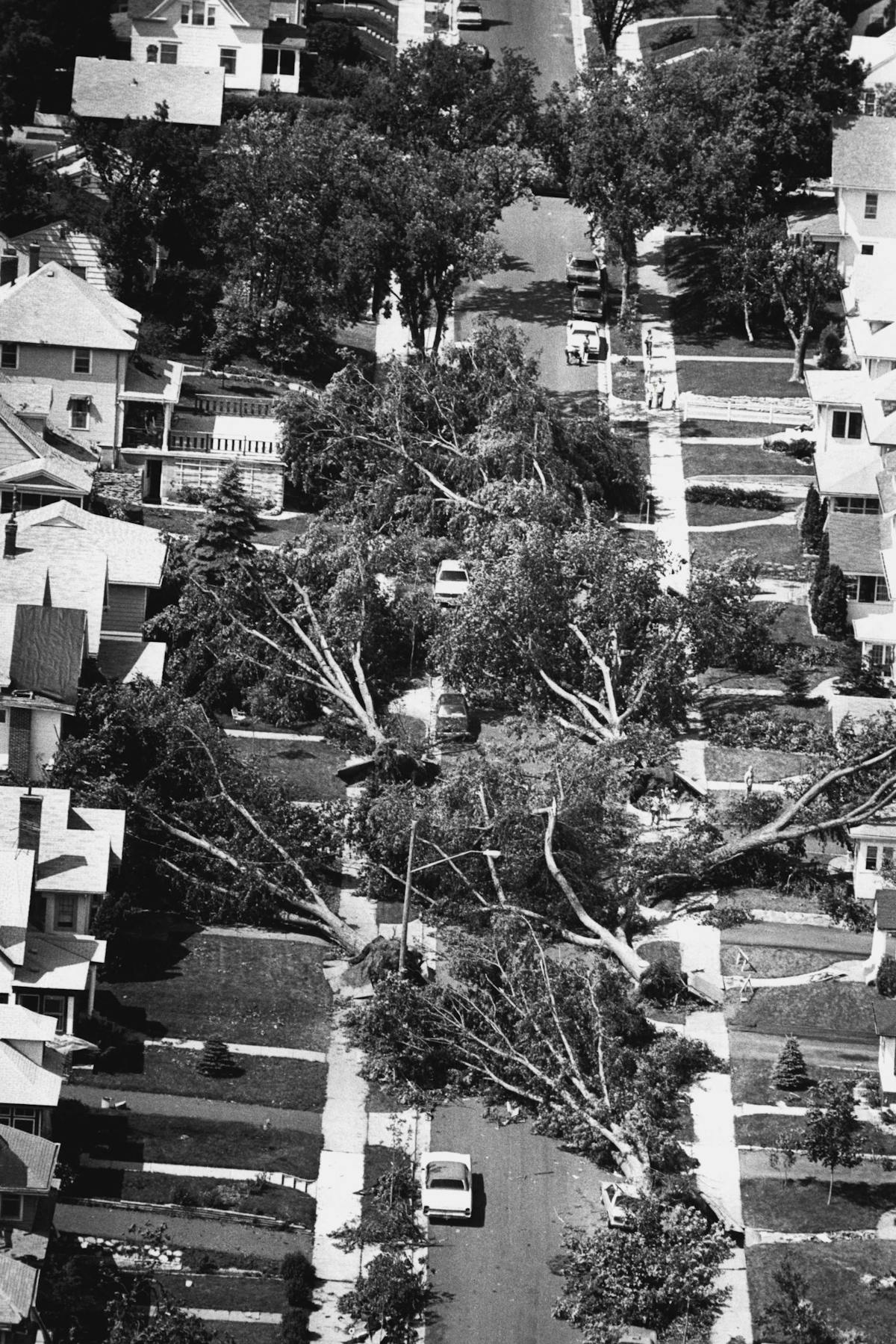
An aerial view of Vincent Avenue after a tornado passed through south Minneapolis in 1981. Tens of thousands of dollars went to tree replacement; 40 years later, the area is lush again.
Paul Domholt, the Park Board's community forestry coordinator in 1981, recalls that when the Neighborhood Revitalization Program came along a decade later, south Minneapolis neighborhoods allocated tens of thousands of dollars to get trees planted on boulevards and school grounds.
East Harriet spent $26,000 on tree planting in 1993 and put $12,700 in a tree replacement reserve — nearly $80,000 in 2022 dollars. The neighborhood allotted $7,000 to urban forestry and boulevard beautification during the second phase of the program, and in more recent years, $2,400 to emerald ash borer treatment.
By the time the 2011 tornado hit north Minneapolis, the Neighborhood Revitalization Program was winding to a close.
The next generation of forestry
To encourage planting on private property, Tree Trust runs the city's annual tree sale. The saplings are hearty — an inch in diameter and 6 feet tall. In the spring, those who live within the Northside and Southside Green Zones can claim up to three per property for $30 a pop. Everyone else can have two.
Over the past 17 years, the city has furnished about 20,000 trees to private properties.
It is not nearly enough. Trees at risk of emerald ash borer are estimated to number 200,000 citywide — not to mention storms, road salt, vandalism and other causes of death. But with the majority of land held in private hands, the onus of growing Minneapolis' urban forest falls to hundreds of thousands of individuals on a volunteer basis.
For now, most efforts focus on growing trees on public land, where it is easier.
Minneapolis has committed $1 million of federal COVID relief money to plant 18,000 city trees over the next two years.
And with the conclusion of the Park Board's eight-year Tree Preservation and Reforestation Levy, which replaced about 40,000 trees lost to storms and emerald ash borer through the end of 2021, the parks created a public-private carbon credit offset program to generate more money.
The program involves selling carbon offset credits to local corporations. Rather than merely replacing dying trees on a one-to-one ratio as the levy did, the carbon offset program aims to make enough money to actually expand the canopy.
Park Commissioner Steffanie Musich underscored the urgency: "The best time to have planted a tree was 20 years ago. We unfortunately don't have time machines. So we need to be planting for 20 years from now."
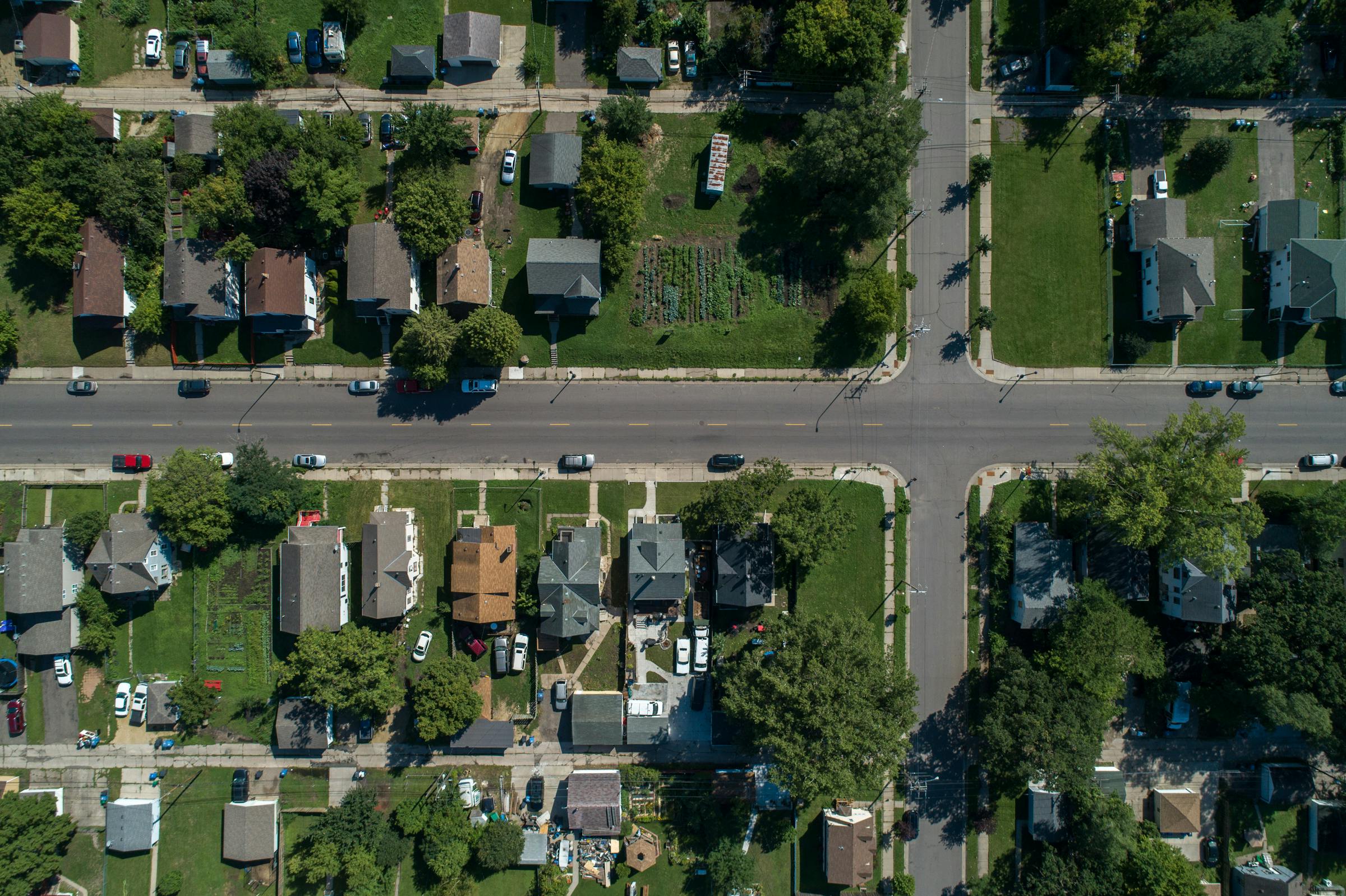
Scars from the 2011 tornado are still visible in the Willard-Hay neighborhood, where undeveloped and treeless lots contrast with neighboring blocks. Though trees on public land were swiftly replanted, private property stayed bare.

